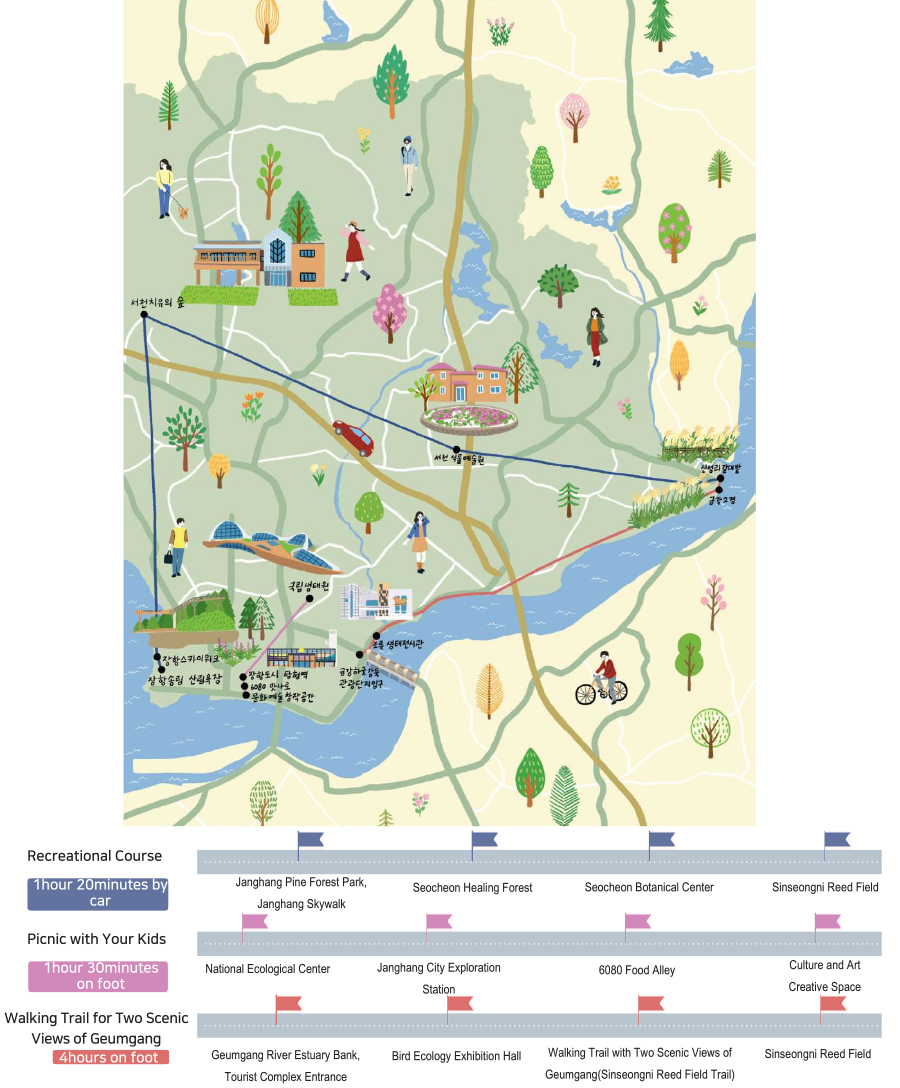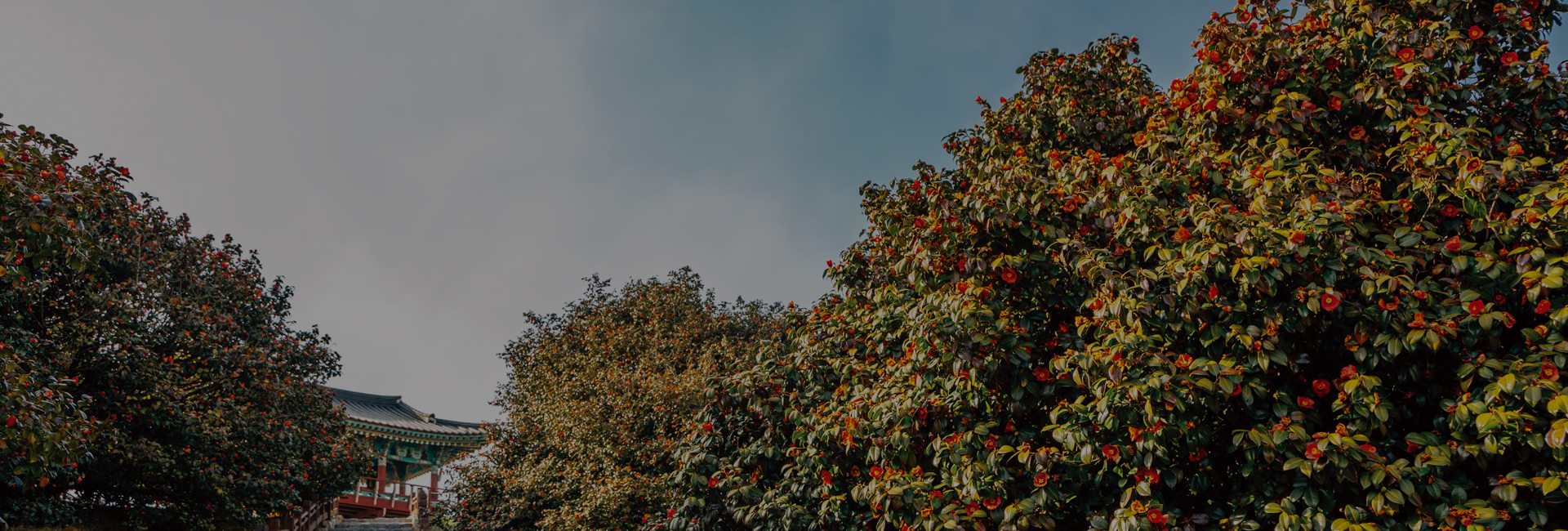
- Water, Nature and Humankind
- Travel for Save the Earth
-
Let the Earth shine
more by protecting it
“Environmentally-Friendly
Eco-Exploration Destination”
Seocheon Janghang Skywalk & Songnim Forest Park- Written and photographed by. Lee Si-mok(travel writer), Seocheon-gun
- Today, we have become used to a term like ‘carbon neutral’ and have seen a growing interest in eco-friendliness. This tendency seems to be attracting more attention to “RED”, the acronym for “Recommended Eco-friendly Destinations” selected by the Korea Tourism Organization and the National Council for Tourism Promotion. The term is often used in phrases like ‘RED for the planet’ or ‘RED for carbon reduction’. Seocheon Janghang Skywalk and Songnim Forest Park also fall under this category. As such, they have been chosen as ‘Environmentally-Friendly Eco-Exploration Destinations’, stressing that they are places where you can enjoy nature while considering and protecting it. Let’s go to Seocheon to experience an ‘environmentally great forest’ this spring!
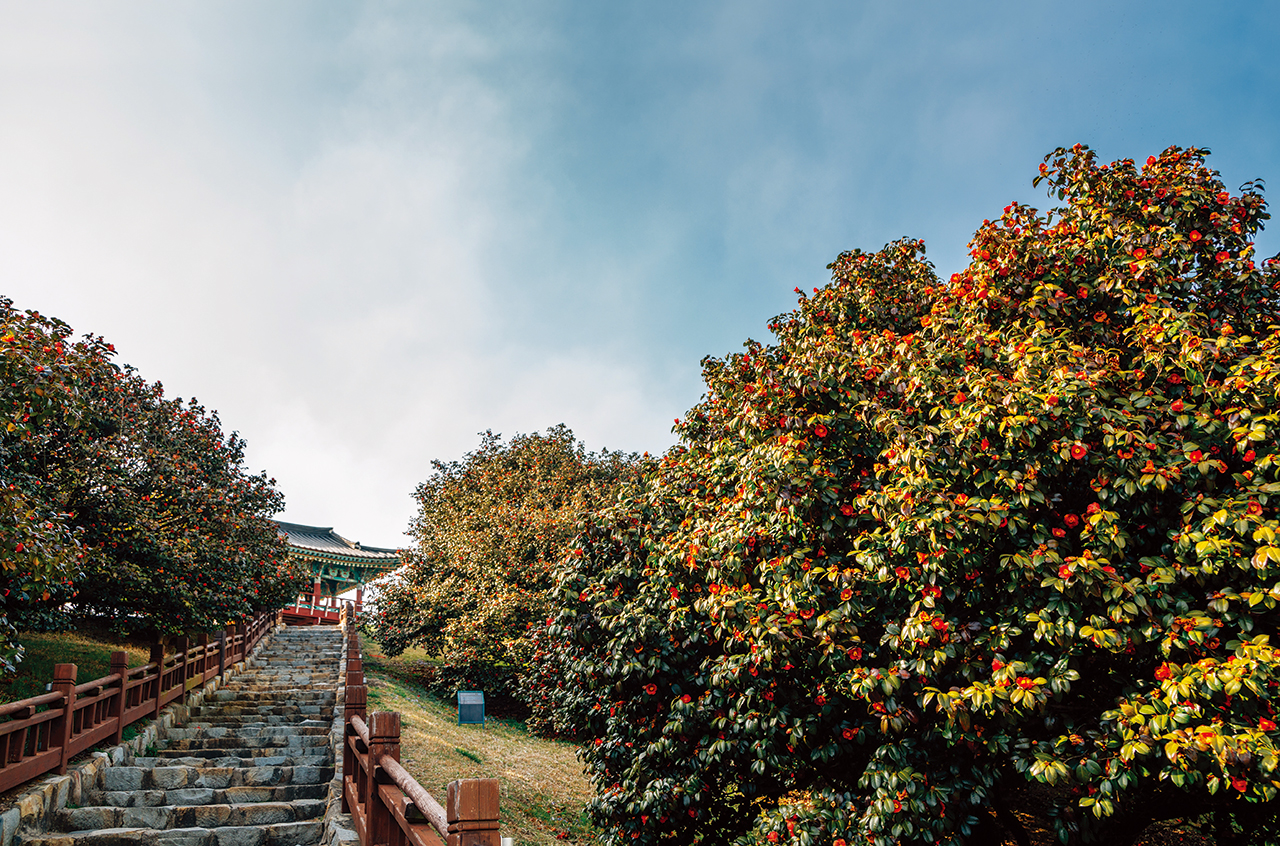
Choosing Ecological Conservation over Development
Seocheon is a special place in many ways and has many special features. First of all, it has two UNESCO World Heritages: one is the “Weaving of Mosi(fine ramie) in Hansan”, an intangible cultural heritage, and the other is the “Korean Mudflats”, a World Natural Heritage. Many obervers beleive that now is the ‘time for Seocheon’.
Seocheon also stands out in other respects. For instance, Seocheon is a great eco-city whose key clean areas include the Geumgang River Estuary and Yubudo Island. These are real paradises for migratory birds that, along with the “Seocheon Mudflat”, a World Natural Heritage site, have been selected as “Eco-friendly Destinations” by the Ministry of Environment for nine consecutive years. The Janghang Skywalk and Songnim Forest Park, ‘the RED for the Planet’, are also located in the area. Moreover, it is located at the tip of the Geumgang River Estuary, where the Geumgang River meets the West Sea, allowing you to enjoy the river, the sea, the forest, and the mudflat at the same time. This area is tightly connected to ‘ecology’ and ‘low carbon eco-friendly’.
However, it hasn’t been long since Seocheon became familiar with the term “ecology”. Back when every region was building industrial complexes by reclaiming mudflats and deforestation, Seocheon protected its forests and mudflats by opting for ecological conservation. However, Seocheon did not protect them simply by letting them be, but actively selected ecological conservation at a crossroads of development and conservation. It actively protected the mudflats and forests that were on the verge of disappearing. This is why conservation is still the future of Seocheon.
 1. You can see the tidal channels up close on the mudflat trail.
1. You can see the tidal channels up close on the mudflat trail.
Do you wish to be healed by nature?
Last March, someone asked, “Where is the Skywalk?” That person asked for directions, saying that “The forest is bigger than I thought, so I couldn’t see it even after walking for a long time.” That ‘bigger forest’, whether an object of complaint or admiration, is Janghang Forest Park.
Janghang Pine Forest Park, a treasure of Seocheon, is home to over 130,000 black pine trees aged at least 40 to 50years. Located near the beach area, it is so big that it makes it impossible to see the Skywalk, even though it 15m high and 286m long.
History tells us that this forest was planted as a windbreak in 1954 by students of the old Janghang Agricultural High School in order to block out the sea breeze in particular. A windbreak forest is, so to speak, a place where the wind is held captive and calmed after passing across the sea. That’s why the forest offers us a gentle breeze of pine needles containing phytoncides, whcich make our bodies feel lighter and our minds brighter.
The Janghang Pine Forest also offers various practical benefits to the sea area. It protects villages from sea breezes, prevents the loss of sand from coastal dunes, and serves as a spawning ground for diverse sea creatures. The Korea Forest Service recognized these benefits and the value of the Janghang Pine Forest and designated it as a National Forest Asset in 2020. Several trails wind through the forest, each forming a great hiking course, including a fine sandy path, a well-trodden pebble path, and a path matted with soft palm leaves. I personally would recommend a walk in late summer when the big blue lilyturf plants blossom like a fluffy carpet. The trail exudes a different kind of charm on a spring day full of green energy.
 2. Several kids looking at the mudflats on the northern beach of Janghang Pine Forest Park.
2. Several kids looking at the mudflats on the northern beach of Janghang Pine Forest Park.
The Janghang Pine Forest Skywalk Commands a Scenic View of the West Sea Mudflats
The middle section of the forrest path is the skywalk section, in which you could see the sea area. The Skywalk rises up into the sky and extends to the sea in a zigzag pattern at the same height as the tall pine trees, allowing you to admire the leaves and the cones of the black pine trees as you stroll along it. Most of the Skywalk’s pillars are situated in the forest, but the last one is sunk into the mudflat, allowing you to enjoy a walk above the forest and the sea. In particular, you can walk on the sea at high tide because the last pillar is submerged in the water, while you walk on the mudflat full of ripple marks at low tide.
The center of the Skywalk also serves as the Gibeolpo Naval Battle Observatory. Gibeolpo, the old name of this place, is where the Silla Dynasty fought and won its last battle with the Tang Dynasty in 676. This makes the Janghnag Skywalk the ideal destination to enjoy scenic views of the forest, the sea(mudflat), the industrial site of the Janghang Refinery, and a historical site where you can get a fascinating glimpse into the past.
If you have enough time, you could take a walk toward the mudflat just outside the 1.8-kilometer-long Janghang Pine Forest. The mudflat trail, which begins at the end of the Black Pine Forest, is a good place to take a closer look at the Seocheon mudflats. On one side is a coastal cliff and on the other side is a wide mudflat, allowing you to enjoy different scenery from the Janghang Pine Forest. You can also see birds like the snowy heron, the Chinese egret, and the great egret, which will make you appreciate Seocheon's decision even more.
 3. Big blue lilyturfs blossom under the trees in late summer on the trail in Janghang Pine Forest Park.
3. Big blue lilyturfs blossom under the trees in late summer on the trail in Janghang Pine Forest Park.
- Wise “Eco-friendly” Traveling
- Four promises for visitors to the Janghang Pine Forest Park
-
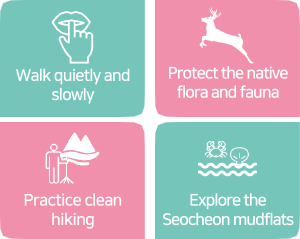
-
How to Have More Fun at Janghnag Pine Forest Park
_ Participate in the “Eco Heroes Adventure 2”
“Eco Heroes Adventure 2” allows you to fully enjoy Janghang Pine Forest Park and the surrounding mudflats. “Eco Heroes Adventure 2” is a contactless family-centered eco-tour program that has won the Chungcheongnam-do Environmental Education Program Excellence Award. It helps visitors to learn about the local ecology by completing missions in the pine forest and the Sinseongni Reed Field(or Geumgang Ecological Park). You will need a car, and will have to reserve a visit in advance. The program runs every Saturday and Sunday from April to October. If you wish to take part in the program, please contact the Seocheon-gun Bird Ecology Exhibition Hall(+82-41- 956-4002).
 Seocheon’s Top Attractions
Seocheon’s Top Attractions

-
Fascinating Wild Carmelia Field in All Four Seasons
Maryangni Camelia Forest
This is the hottest spot in Seocheon during the camellia season. This camellia forest(Natural Monument No. 169), located on a hillside to the northeast of Maryangpogu Port, consists of about 80 camellia trees that are over 500years old. The camellia flower blooms from mid-March to mid-April, and sometimes until late May. A middle-level pavilion, called the Camellia Pavilion, is positioned on the hilltop where it commands a great view. From there, you can see the red camellia forest during the daytime and enjoy the vermilion scenery created by Oyeokdo Island and the West Sea at sunset.
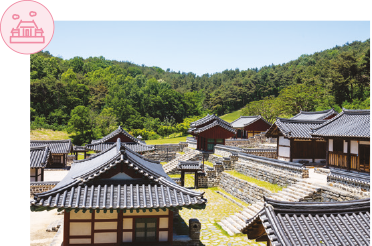
-
Shooting locations of K-dramas such as The King’s Affection, The Red Sleeve, etc.
Munheonseowon Confucian Academy
This Confucian academy surrounded by attractive scenery has been used a filming location for K-dramas such as The King’s Affection, The Red Sleeve, and Love in the Moonlight. The moment you step inside, you will feel as if you are 'time slipping’ back into the past. At the end of the Goryeo Dynasty, Lee Gok and his son Lee Mok built this academy to commemorate the renowned scholar Lee Saek and his virtues. It was demolished in accordance with the decree ordering the abolition of all Confucian academies issued by the regent Heungseon Daewongun in 1871, but it was rebuilt in 1969. The most beautiful time is in late summer when the banyan trees are in bloom, but the springtime scenery when the new shoots are in bloom is also wonderful.

-
Beloved Photo Zone with Unique Interior Design
Janghang City Exploration Station
This is a complex cultural facility remodeled from the old Janghang Station. A ‘Dichroic film’, also called a “rainbow film”, has been pasted on each window to create a unique aura. Inside, there is the Janghang Story Museum where you can see the history of Janghang, as well as the City Exploration Observatory where you can look down on Janghang city, the retro style City Exploration Café, and a free bicycle rental shop. Interesting exhibitions and performances are also held there. Among these attractions, the City Exploration Café is where travelers tend to stay the longest. Its signature drink is its Moshi(Ramie) Latte, whch is made with ramie leaf powder.
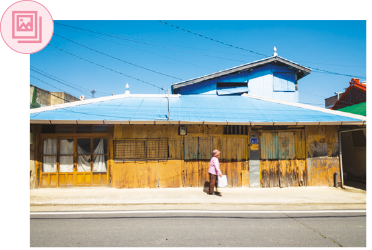
-
‘Real Retro’ Destinations with Olden Day Scenery
Pangyo Village
Pangyo is a place where traces of the passing years have piled up layer by layer. The village is filled with old places, as if it existed over half a century ago. Must-see places include the Dongil Rice Mill, Dongil Brewery, Rose Photo Gallery, O Rice Mill(Samhwa Rice Mill), Pangyo Theater, Old Company Headquarters, and Ilgwang Store. These seven places have been designated as local cultural heritage sites. Pangyo Station also attracts many people due to its analog atmosphere. Currently, it is being remodeled as it has been selected as a spot for the Cultural Regeneration Project for Unused and Abandoned Industrial Facilities of the Ministry of Culture, Sports and Tourism. Why not take a look before it transforms itself!
 List of Tasty Eateries in Seochon
List of Tasty Eateries in Seochon
-
-
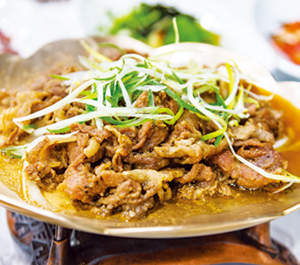
-
Surawon
Surawon has been selected as an ‘affordable restaurant' on SNS. Its s ignature menu is the grilled bulgogi set, which has a rich charcoal flavor. The restaurant serves pork seasoned w ith soy sauce in a brass bowl on a mi ni-sized brazier after grilling it on a gridiron, accompanied by delicious side d ishes such as spicy soybean paste st ew.
-
-
-

-
Jinmi Eatery
Opened in 1978, Jinmi Eatery is a so ybean noodle restaurant that only se rves soybean noodles, makguksu(buckwheat noodles), and so ybean pancakes. The delicious so ybean soup is appreciated for its strong taste, while the savory so ybean pancakes roasted like crispy nu rungji(crust of overcooked rice) are also excellent. It is only open for 5 months of the year from mid-April to mid-September.
-
-
-
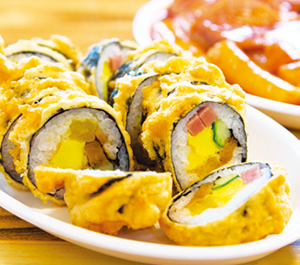
-
W onjo Keungil Hyugesil
This ‘Snack food eatery’ with over 30 years of history is located in Janghang, Seocheon. Its signature menu is Deep-fried Gimbap, which, as its name suggests, is made by deep-frying whole gimbap. The frying paste is prepared with beef bone broth to give it a deeper, more savory taste. Fresh Deep-fried Gimbap the perfect accompaniment for sweet and spicy Tteokbokki(spicy stir-fried rice cakes).
-
-
-

-
Moshirang Seafood Home-made Noodle Soup
Mosirang serves seafood homemade noodle soup that gives you a ‘taste of the sea at the table’. The incredibly tasty noodles are made by mixing Seocheon's special product, Moshi(ramie) leaf powder, while the savory soup is packed with shellfish such as scallops, surf clams, and clams. The restaurant also serves popular Moshi(ramie) songpyeon(half-moon-shaped rice cakes) as an appetizer.
-
Enjoy Seocheon to the full
We recommend a stroll along three themed paths where you can enjoy the beautiful natural environment and culture of Seocheon.
